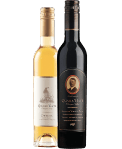Written by Tim Pawsey
Tim Pawsey (The Hired Belly) has been covering the wine & dining scene for 30 years thanks in part to the blossoming wine and dining culture of British Columbia.
Plenty of excitement surrounds the remarkable success of today’s British Columbia Wine Industry—and rightly so. With at last count some 284 licensed grape wineries across the province, the BC industry continues to grow beyond all expectations.
Yet it’s easy to overlook the formidable contribution of the original, relatively small number of determined visionaries who made it all happen. Included in that illustrious group are Quails’ Gate founders the Stewart family. While the winery was established in 1989, the family’s history in the Okanagan Valley dates from much earlier in the 20th century.
Early farming days
Tony Stewart recalls that his grandfather immigrated from Ireland in 1908, travelling across Canada by rail to Coldstream in Vernon. “He was looking for his brother who had come here earlier and landed at what is now the Gellatly Nut Farm Regional Park, just south of present-day Quails’ Gate. The story goes that, as he carried his steamer trunk up from below, Dr. Gellatly was so impressed that he hired him on the spot.”
In 1911, three years after the brothers met up, they started Stewart Brothers Nursery, which in time became the largest nursery in Western Canada.

A shift to grapes
In the 1950s, after Tony and Ben Stewart’s father Richard (Dick) Stewart sold his share in the nursery, he purchased the lower portion of Boucherie Road in 1956 and, later, the upper portion, which combined make up what is now the Quails’ Gate property. In 1961, he planted the first grapes.
While the original plan called for seedless Diamond table grapes, a mix-up at the nursery resulted in Chasselas going into the ground. Later came Verdelet and Marechal Foch. Dick Stewart began working with the Capozzi family, supplying fruit to Calona Wines. In fact, “Dad liked to say it was vin ordinaire that kept the lights on,” says Tony Stewart.

From grower to farm gate
Over the years Dick Stewart began to supply grapes to other wineries, including Jordan & St. Michelle, Gray Monk and Mission Hill, located just up Mt. Boucherie. The family decided to open their own farm gate winery in 1989 with Ben (Tony’s brother) and Ruth Stewart at the helm. The first few wines were made at Mission Hill by winemaker Daniel Lagnaze. The first commercial release was in 1990.
The initial, humble winery was housed in a converted farm building.
“Back then the rule was that if you fermented onsite, you had to bottle onsite”, says Stewart, “so they had to buy a bottling line and make some other adjustments to the space.”
Not until 1993 did the winery expand into a more suitable facility, recalls Stewart, with the most significant remodelling taking place five years later in 1998.

Quails’ Gate continued to grow with methodical and meticulous planning, including the opening of Old Vines Patio in 1999 which was among the first in the valley, expanding to Old Vines Restaurant in 2005. “There was always plenty going on, and there still is,” says Stewart. “We’re focused on continuous improvement and are always looking at ways in which we can innovate and improve upon what we’ve built.”
The next generation
Tony’s son, assistant winemaker Rowan Stewart represents the new generation. He started working in the vineyard when he was young, helping with part-time work as a teenager and eventually moving to Old Vines Restaurant. “I liked those tips back in the day,” he laughs, although it was never a given that he would wind up working in the industry.
“When I was younger, I wasn’t sure I wanted to work in wine,” he confides. “I tried out some other things and then after a year or so I realized I quite enjoyed working in the industry. So I went to New Zealand, studied there for three years, and spent quite a bit of time working in the vineyards.”
Rowan enjoyed his stay, spending most of his time in Marlborough and some in Canterbury. What impressed him most was the New Zealanders’ efficiency—which he says the rest of the world has yet to figure out. Because their primary variety ripens and comes in right at the same time, “They really know how to bring in fruit like no one else, ” he says.
Since then, he’s broadened his knowledge further, working in Sonoma and Napa to study bold, big reds, as well as in Niagara.
Rowan’s cousin and Ben Stewart’s daughter, Llane Dobbener is also part of the next generation to continue the family’s legacy. Llane grew up on the farm and remembers helping the family business at a young age by picking grapes, driving tractors, labelling wines and adding the foil caps to bottles, but it was her passion for people that landed her in her current role of human resources coordinator.
“Growing up in a wine family onsite with your father having the dream and passion to start a winery, it’s hard not to have that passion passed down through the generations. In my current role, I get to combine my passion for people and wine. What I love about wine and winemaking is that it’s a catalyst for wonderful memories made with loved ones and bringing people together which is a beautiful thing.”
The Founders’ Series evolves
Having worked the last three harvests at Quails’ Gate, Rowan Stewart has some good insights, especially when it comes to the Rosemary’s Block Chardonnay and Richard’s Block Pinot Noir. Of note, in 1975 Dick Stewart was one of the very first to plant Pinot Noir in the Okanagan, laying the foundation for what would later become the winery’s flagship red variety.
“They are of course based on site selection,” he says, noting the wines receive the team’s fullest attention. However, “the vineyard is what gives us that next level of flavour, complexity and balance. In the winery, we work on making sure our choices are subtle. We don’t want to overpower the fruit. We want to enhance it. We’re focused on that right now and trying to fine-tune how much oak we use.”
When working on the Richard’s Block Pinot Noir, the team “uses open-top fermenters, with more frequent hand punch downs, and with more attention compared to a bigger Pinot Noir block. “We do everything we can to maintain that fruit and terroir,” he adds.
Rosemary’s Block Chardonnay—named for his grandmother—originally was a barrel selection. “Eventually it was fine-tuned by sourcing from the lower half of the vineyard, from some blocks on the left hand of the property that are quite different in vigour and soil composition.”
Looking ahead
Rowan is excited about what the future holds. Recently some older, struggling plantings of Riesling and Optima were removed to make way for new vines. “That site is the best terroir near the winery, with a great aspect. There we can ripen more effectively, so we’ve replanted with Pinot Noir and Syrah. We’ve never had Pinot Noir planted on the lower half of the vineyard. I think it will be awesome to see what happens and compare the lower-half Pinot Noir with the Pinot Noir from the upper half of the vineyard,” he says.
A time to be thankful
Perhaps not surprisingly, the Founders’ Series wines have a special place in Rowan’s heart. “I wish I’d been able to spend more time talking to my grandfather. I got into wine during the last couple of years of his life. I wish I’d talked to him sooner, to learn more of that old farmer knowledge.”
“I see my grandmother fairly regularly—and I hope that she’s excited to show people and share with them the wines we create. Particularly the Rosemary’s Block.”
Rowan says it’s interesting to be part of a family that’s been growing in the area for all these years.
“It’s so great to be involved now,” says Rowan, who adds that he’s grateful his father “was always very careful we didn’t feel obligated to go into the family business.”
“Now I feel I very confident it’s exactly where I want to be.”
2020 FOUNDERS’ WINES
Rosemary’s Block Chardonnay
Hand harvested from 24-year-old vines on contrasting silty clay and sandy loam soils, above Boucherie Road. Whole cluster pressed and partially barrel fermented in new and old French oak that allows the fruit to shine. Lifted orchard fruits, stone fruit and citrus aromas lead to a generously textured but well-balanced palate of apple and pear, with a creamy note, underpinned by bright acidity and a touch of minerality through the lingering close. Enjoy with lighter seafood dishes and cream sauces such as grilled halibut or seared scallops. 92 pts.
Richard’s Block Pinot Noir
Made from 20-year-old vines grown on silty clay and sandy loam, certified sustainably farmed, hand harvested with blocks kept separate. Aged in French oak for ten months. Forward, vibrant red berry and herbal hints precede an approachable strawberry and cherry-toned palate wrapped in silky, well-integrated tannins; supple, layered and complex, showing judicious use of oak with a lengthy finish. Pair with wild mushroom risotto, roasted duck breast or braised fall vegetables. 93 pts.







